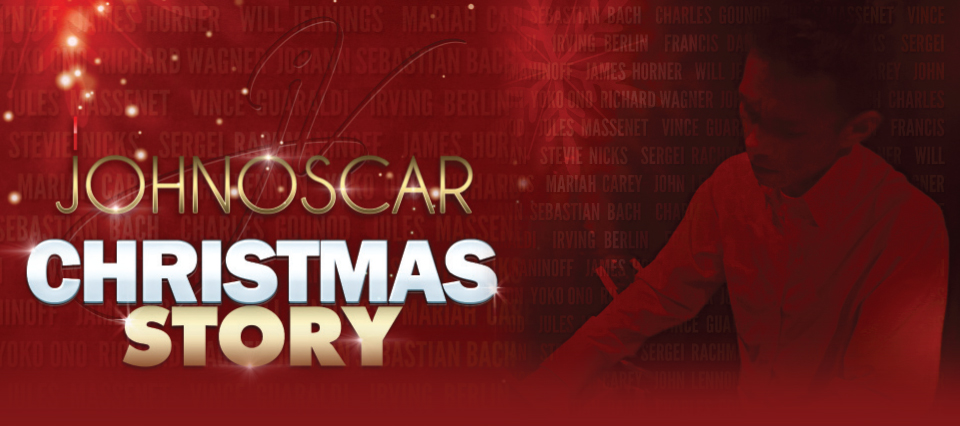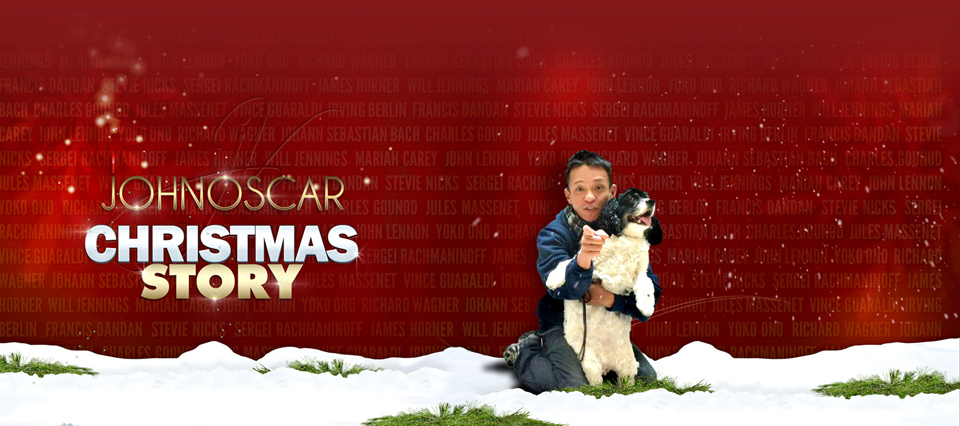"Notes from the Producer" by Kevin Brant
A Christmas Story |
This is about Christmas. It is also about one particular Christmas. It is about a Johnoscar Christmas and the transformation that ensued.
In October of 2012 Johnoscar and I explored our mutual love for Christmas music while staying in a hotel in midtown New York, as Hurricane Sandy struck the city. No matter what is happening in our lives or the world around us, Christmas music has the power to evoke a holiday spirit. We both love its beauty, its complex pallet of emotions along with inspirational appeal for peace, love and joy--but most of all we love its ability to create a spirit unlike any other body of music associated with any other holiday.
While the tropical storm battered our high rise hotel, we began to imagine an album that would propel the listener through a Christmas music drama by drawing from a variety of song writers and composers that could be felt and related to, as if the story were the listener’s own. |
|
Coming to America |
|
In every good story the primary character has a good back story and this story is no exception.
After landing a first place position for the second time in a national piano competition in the Philippines 14 year old Johnoscar found himself presented with two options: He could take a first place prize of a million (Filipino) pesos—a small fortune to most—or go to the United States for his first glimpse of his life-long dream: to study, live, perform and succeed as an artist in America. Cecile Licad, the renowned pianist and the juror and a juror in the competition Johnoscar won, pleaded with the young contestant to take the money and run. Instead Johnoscar grabbed his ticket, organized his paperwork and prepared for his first small tour as a classical pianist in America. Johnoscar’s blistering speed and heart-wrenching musicality made a strong impact upon the audiences, while the audience response and sold-out tour made a strong impact upon Johnoscar.
Johnoscar returned to the Philippines after his tour ended, he eventually came back to the US as a prelaw student at New York University in compliance with his family plans—but his dreams lay elsewhere. Before completing even one semester at NYU, he auditioned for, and received, a full scholarship to Juilliard to study piano under Norma Berlin and Gary Graffman.
The United States did not always embrace Johnoscar with open arms. The funds his family sent were quickly consumed during his first semester at NYU. His scholarship to Juilliard covered tuition but no books or the expense of living in New York City. Johnoscar soon found himself jumping the gates of the New York Subway system to sleep in the trains while his classmates slept tidy in their dorm.
While pursuing his studies at Juilliard, Johnoscar took a job washing dishes at the Manila Garden. Upon discovering the dishwasher’s musical talent, the management offered Johnoscar a position in the front room—at the piano—which he accepted with one condition: that he be allowed to continue washing the dishes because he desperately needed the money. Johnoscar’s performances of Broadway music soon became the restaurant’s primary appeal. Upon Johnoscar’s graduation from Juilliard, the restaurant was forced to close its doors, unable to find a pianist with comparable talent or charisma.
After graduation, and after performing Rachmaninoff’s Second piano concerto in Davies Hall, Johnoscar moved to San Francisco. While arranging his career as a concert pianist, took a job as a sandwich maker at Bonte in the Financial District. Because his early appearances were bringing him some element of fame, his stint at the sandwich shop became a well known part of his story. His ability to make 500 sandwiches in an hour made him invaluable to the establishment. Johnoscar became so identified with the enterprise that after his career took off this business too was forced to close its doors.
As Johnoscar’s star began to rise, he found himself auditioning, competing, performing and even practicing with many of the living legends of classical music. Within a short period of time he had performed in almost every US state plus concerts in Asia and Europe. As the demand grew, his fee per performance rose to the same small fortune that he declined in the Philippines (most going to management and corporations that hitched their wagons to the rising star). He appeared at the Verbier Festival in Switzerland and was slated to perform Tchaikovsky’s First Piano Concerto as a soloist at the Chicago Symphony Orchestra’s Gala of the Century. But beneath the surface problems began to rise as well. Short-sighted management, an undiagnosed sleep disorder, and a bad long-term relationship conspired to take a toll on the rise star. |
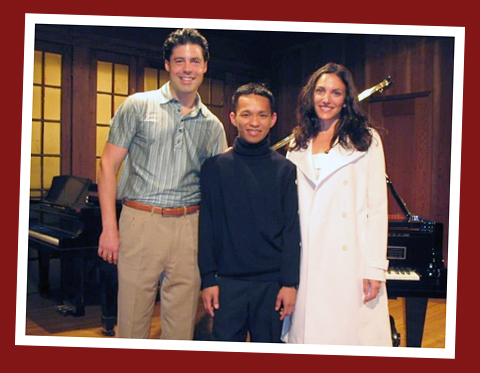
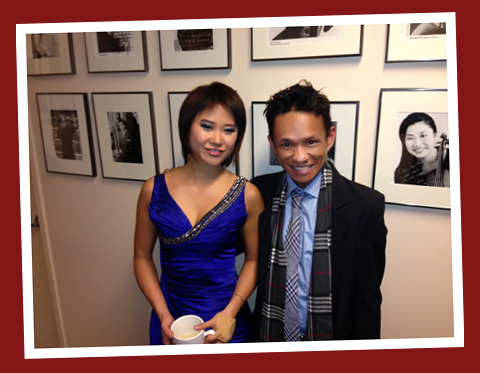
|
| The Origin of Christmas |
Johnoscar planted the first seed for this project in 2010 two years prior to my involvement at the hotel in New York City.
A series of catastrophes had befallen the pianist. A missed concert date damaged his credibility. A stormy 13 year relationship battered his life and career before finally failing, leaving his life in shambles: without a home, without confidence and without a piano to give his life purpose, inspiration, value and hope. Just when he thought things could not get worse, at the young age of 29, a terminal diagnosis left him without the expectation of surviving the holiday season.
As Johnoscar contemplated his fate, he began to imagine creating a rather unconventional Christmas album, performed on only the piano, as a departing gift to those who remained at his side. One friend’s recorder and another friend’s piano became the tools for, what appeared destined to be, his swan song. Copies of the album were distributed along with clothes and his few other remaining possessions. As Johnoscar’s health continued to decline, his weight dropping from 130 to 86 pounds, something unexpected happened: he survived. |
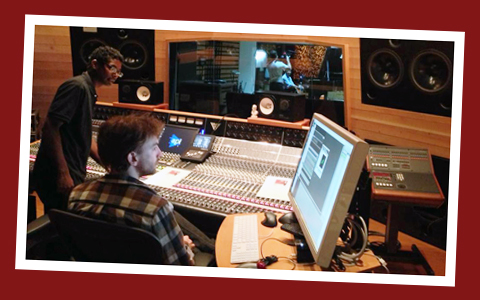
|
| Capturing Christmas in Sound and Vision |
After the storm lifted and the skies cleared in the aftermath of Sandy, we entered the recording studio in NY and began a process that eventually took Johnoscar and me west to San Mateo, Berkeley and Oakland. With each stop, musical selections were added, some were cut and others rearranged until the album progressed to the cohesive comprehensive conception we imagined in our hotel during the tropical storm.
Our musical expedition travels through a variety of genres: Baroque, classical, jazz, popular, and opera, exploring the romantic expectations, the crazy realities, the ideal hopes and the mystical meaning behind Christmas. The album pulls together composers and song writers as diverse as Richard Wagner, John Lennon, Sergei Rachmaninoff and Irving Berlin. The music tells Johnoscar’s Christmas story, through selections that take the listener on a magic keyboard ride. Each selection works with the others to produce a meaningful musical progression: like a tone poem for piano.
The challenges we faced on this project were closer to those of a conceptual work like a Pink Floyd album or a Robert Wilson opera rather than the usual Christmas compendium. Johnoscar’s performance on the piano was the only voice to be recorded. Except for one track, the Filipino Christmas song “Pasko Na Sinta Ko” (a song about missing someone at Christmas) the entire CD was recorded on a 1913 Steinway in Oakland. A filmmaker’s cameras rolled through the three sessions that comprised the final recording: one at Fantasy in Berkeley and two at 25th Street in Oakland. The East Bay recording sessions were sorted and mixed on the peninsula in San Mateo, California by myself and Jermaine Hamilton, the recording engineer.
|
|
This is not a typical holiday album but a work of art—born from experience, pain and, ultimately, the ecstasy of a transcendent triumph over a dark destiny—which happens to be called Christmas. This album is about expectations and reality, catastrophe and transformation—and redemption—in a world that can batter us more than a building clobbered by the turbulence of a tropical storm.
The album concludes with a never before recorded piano transcription from the musical drama Parsifal by Richard Wagner: The story of the discovery of the truth—in the form of the Holy Grail—through the eyes of a young man so innocent he is deemed a fool. It is the age old glorification of Christ and God in a tale so relevant today; it served as the basis for the lead character Neo in the 1999 fi lm The Matrix. Every work of art is a product of the era of its creation and Johnoscar’s Christmas is noexception. As Parsifal could see through Klingsor’s illusions, Neo could see beyond the illusions of The Matrix. Parsifal is symbolic and profound. No work in music captures the essence of spiritual transformation better than Parsifal. And there is no better way to express the true heart of a subjectas emotional and complex as this than through the noumenon possibilities presented by pure music. Debussy described Parsifal as “one of the loveliest monuments of sound ever raised to the serene glory of music.” The music is about Christmas, and the music is by Johnoscar, and the recording is unlike anyother Christmas album made before.
To paraphrase William Carlos Williams, hold back the edges of your gowns, ladies. You are about to go on a sublime and melodious holiday ride traveling from the calm eye to the outer vortex of a musical hurricane—on a path through the head, heart and soul—called Christmas.
CHRISTMAS CREDITS
* Mike Wells Master Engineer
* Jermaine Hamilton Recording Engineer
* Assistant Engr,John Smart
* Marcell Arvy - Graphic Designed
* Jesee Walker - Videography and Video Editing
* Producer Kevin Brant
Webpage Graphic Designed
* Eric Rynne
CD Graphic Designed
* Sabine Heusler - Schick
* Pierre Alain Clauzin
* Marcell Arvy
|
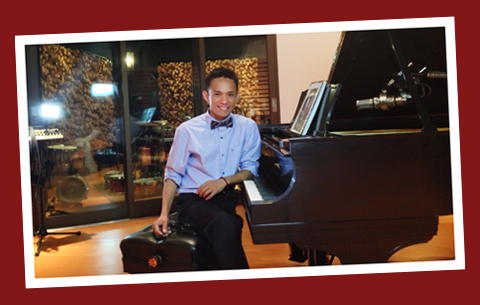
|
|
